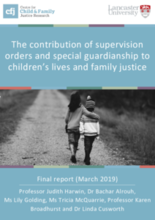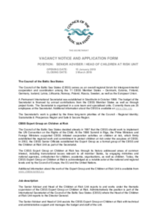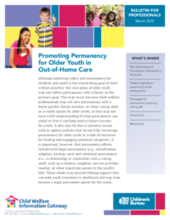Demographic Data
|
Sources: World Bank, UNICEF,UNDP HDR 2015, DHS 2014 |
Displaying 6441 - 6450 of 14390
This report is about the use of ‘family orders’ to support family reunification and placement with family and friends as outcomes of S31 care and supervision proceedings brought under the UK Children Act 1989. The over-arching aim of this study is to understand the opportunities, challenges and outcomes of these orders, and their use at national and regional level.
Using qualitative methods of data collection, factors influencing child placement in Southwestern Nigeria were examined in this article.
This study draws upon data from the Bucharest Early Intervention Project (BEIP), a longitudinal study exploring the impact of severe psychosocial deprivation on child health and development to examine the relationship between telomere length and psychopathology.
This presentation is the result of a critical discourse analysis study which explored the stories–through interviews, observations, and journals–of three young adult women who aged out of the foster care system in a region of Central Tennessee.
This opinion piece from the Irish Times explores the high rates of children and young people with care experience within the criminal justice system in Ireland, the factors that contribute to this overrepresentation, the policies (or lack thereof) addressing this issue, and the need for more information and data collection on outcomes for children and young people in care.
The Senior Adviser and Head of Unit assists the CBSS Expert Group on Children at Risk with technical and administrative support and manages the budget and staff of the unit.
This study explores the qualitative responses of child welfare workers in Florida to understand their collaboration experiences, focusing specifically on their perceptions of facilitative factors of collaboration with Intimate partner violence (IPV) services.
"Twenty-nine parents from across Central America who were separated from their children by U.S. immigration agents last year crossed the U.S. border on Saturday, demanding asylum hearings that might allow them to reunite with their children," according to this article from the Washington Post.
This bulletin provides information for child welfare professionals about the importance of permanency for youth and strategies for achieving it. Permanency efforts for youth should include both legal permanency (e.g., reunification, adoption, kinship care) and relational permanency (i.e., a relationship or connection with a caring adult, such as a relative, neighbor, service provider, teacher, or other important person in the youth's life). These adults may provide lifelong support that can help youth transition to adulthood and may even become a legal permanent option for the youth.
Language That Cares is a collaborative effort led by TACT that aims to change the language of the care system. Language is a powerful tool for communication but sometimes the way that it is used in social care creates stigma and barriers for understanding. Language is power, and we want children and young people to feel empowered in their care experience.




